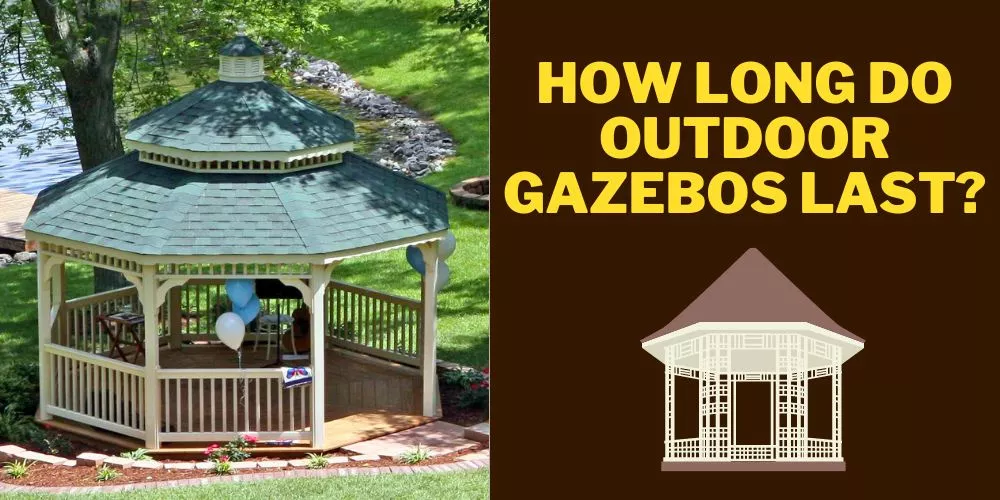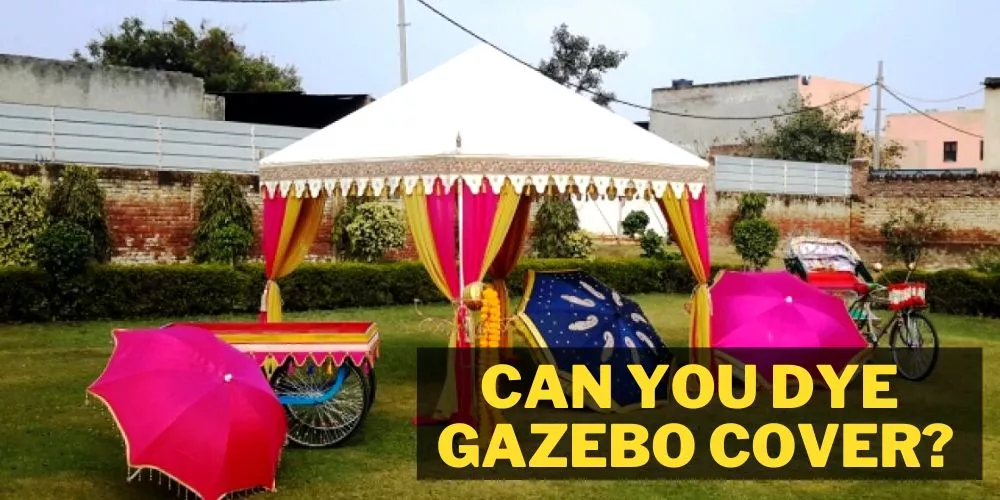When you think of summer, grilling would have to be up there as one of the most popular activities to participate in. However, one of the biggest problems with firing up the old BBQ is the potential of mother nature causing unwanted headaches. Thankfully, a few solid shelter options can help make the experience much more bearable.
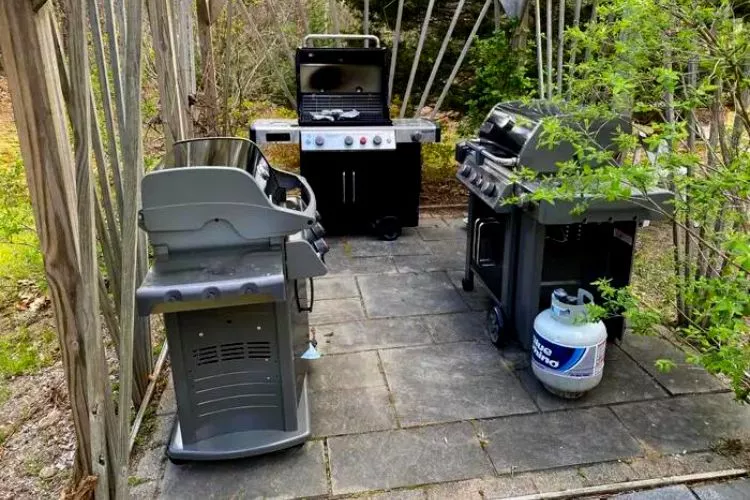
One of the most common covered areas is porches. The question is, though, are they safe options for gas grills? Yes, you can do it taking certain precautions. Grilling with gas is fast and effective, so they’re extremely convenient. But, these advantages have the potential to come at a cost. Therefore, considering the risks and taking precautions are important to the safety of anyone or anything within the surrounding area. This article will guide how to safely and effectively use a gas grill under a covered porch.
Can you put a gas grill under a covered porch?
It’s not always possible to grill out in the open. Especially with the potential of competing against heavy rains, sideways winds, blistering sun, or even just a huge dump of snow. To answer simply, yes you can put a gas grill under a covered porch. Moving your gas grill to a covered porch can help by offering much needed shelter. However, some minor criteria measures should be carefully followed when doing so.
These include making sure that there is adequate ventilation and also ensuring that the covered area is a reasonable distance from above the open flame. Gas is not something that should be used in the way that it isn’t intended to be. The same goes for flames and heat.
How much overhead clearance does a gas grill need?
In general, gas or propane grills require a minimum of 10 feet of clearance on each side. Furthermore, if the grill is installed underneath combustible materials, the area above the grill must be covered with an exhaust hood. Gas grills produce quite a bit of heat,, so allowing that space will minimize the risk of damaging any surrounding surfaces.
Where Should I Place a Gas Grill on My Patio?
The safest way to place a gas grill on a patio is on a clean surface. Avoid flammable debris such as a tree, bush, or gardening material, including leaves, low hanging branches, hedges, mulch, or even rubbish. Keep it away from any walls, covered areas, or other non moveable constructed parts of the patio.
Potential risks of using a gas grill under a covered porch
There are a few safety hazards that grilling using gas under a covered porch can create. These problems can be quite dangerous as gas isn’t something that should be played with in any case. Mix that in with enclosed spaces and combustible or flammable materials,, and you have a recipe for disaster. The potential risks include:
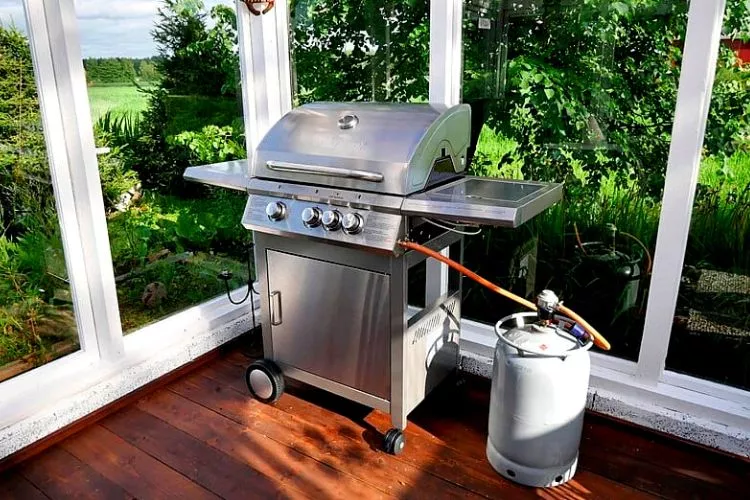
Carbon monoxide poisoning
Carbon monoxide is a chemical produced when natural gasses aren’t properly burnt. This emission occurs when the gas leaks using either faulty products or poor product usage. Carbon monoxide poisoning is generally caused when these gasses are trapped in an area via poor ventilation, and a human or animal is present to inhale it unaware.
Common symptoms of carbon monoxide poisoning include headache, dizziness, weakness, upset stomach, vomiting, chest pain, and confusion. Excess inhalation can lead to passing out or even death.
Fire hazards
Fire hazards are possible when the grill’s gas is left running by accident, or the grill is placed and used too close to flammable or combustible materials. According to the National Fire Prevention Association, 84 percent (5 of every 6 grills) were involved in home fires fuelled by gas.
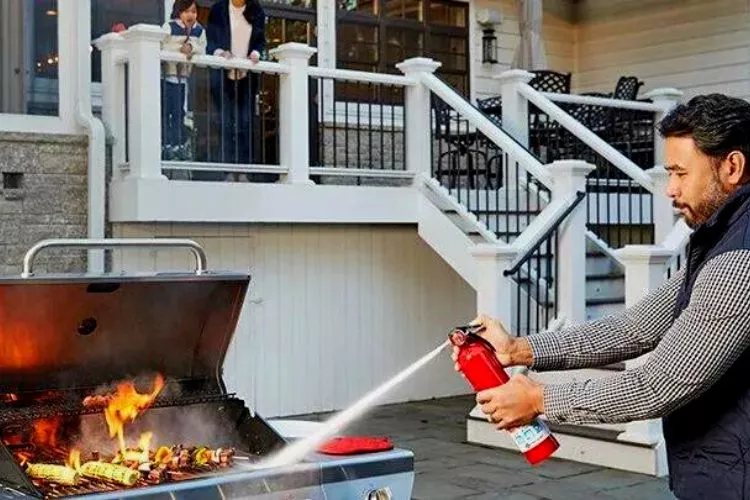
Making sure they are used safely and maintained regularly is essential. Furthermore, simply placing them away from anything that can explode or catch on fire is highly recommended.
Gas leaks
Gas leaks can potentially cause serious damage and harm to anything and anyone. The problem with these issues is that they are often difficult to detect. You can’t see a leak, and the untrained nose may not pick up the scent of wafting gas. Gas leaks can occur when faulty hoses or joining parts aren’t adequately maintained. Simple mistakes can cause carbon monoxide poisoning and explosions, among other dangerous outcomes.
Tips for safely using a gas grill under a covered porch
Covered porches or patios are a great way to keep a hungry pack of guests happy when poor conditions hinder your ability to continue using your grill. Let’s have a look at a few precautionary tips that are worth following to make sure that your grilling with gas experience is a much safer one.
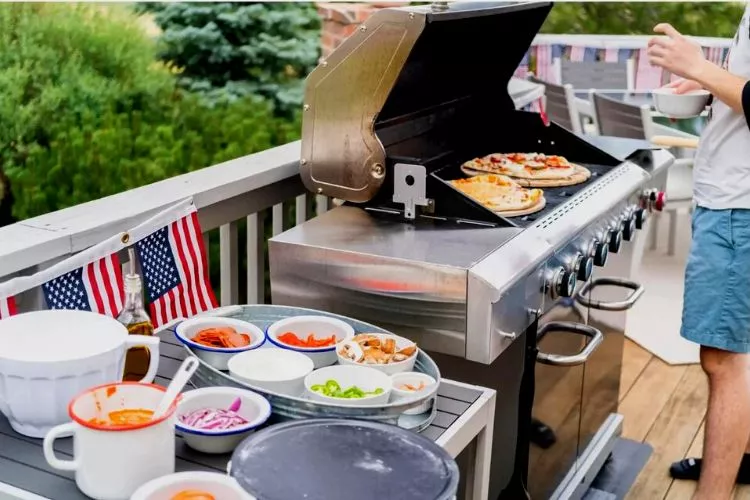
Ensure proper ventilation
Natural gasses can build up pretty fast in poorly ventilated areas. The carbon monoxide emitted is extremely dangerous for a human or animal to inhale. Breathing in too much will make you pass out or even kill you. Furthermore, it can explode if it reaches between 12.5 to 74.2 percent and is mixed with oxygen.
These risks can occur by leaving the gas running, leaks,, or even general use of the grill in poorly ventilated areas. Allowing 10 feet around each side of the grill will help prevent any potential ventilation issues. Aim to keep the grill in as much open space as possible.
Follow manufacturer’s guidelines
Always follow the installation instructions and manufacturer’s guidelines when you purchase a grill. They are provided for a reason, and that is generally for the safety of its user. Suppose you follow these actions carefully and precisely. In that case, there is generally no reason why any potential issues should arise unless, of course, if there is some kind of default in the product.
Keep the grill a safe distance from walls and other surfaces
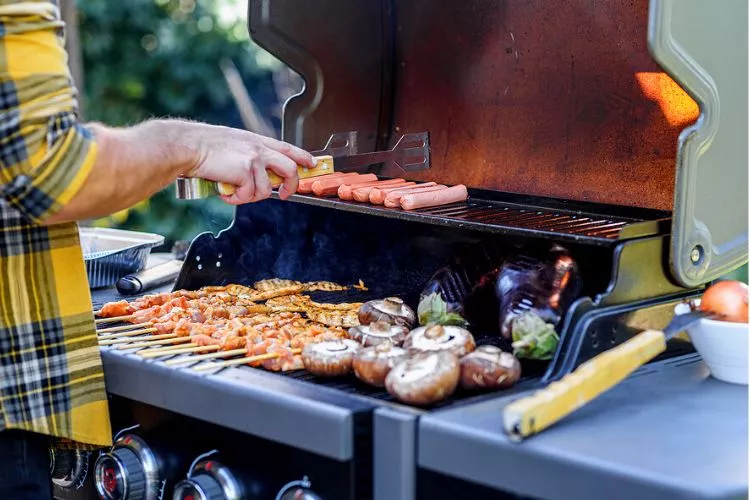
Gas grills produce a surprising amount of heat. The temperature rises fast, and the heat is intense. Any surrounding walls or surfaces that are too close can be at risk of burnt, melted, or damaged. Allowing at least a 10 foot clearance around all sides of the grill is important for the safety of any surrounding materials.
Regularly check and maintain the grill
It’s generally recommended to clean your grill thoroughly every 5-10 uses if it gets fired up frequently. It’s not always possible to do so after each use, as who wants to do that on a full belly anyway. Alternatively, cleaning and maintaining all moving parts should be practiced at least twice a year. This includes inspecting all the gas lines, changing over the gas, and checking the ignitor.
Alternatives to using a gas grill under a covered porch
If you’re worried about the danger of using gas as a fuel source for your grill, you’re in luck because there are other options. The most common alternatives are electric and charcoal.

Each choice has its own advantages and drawbacks, so it’s worth digging deep into their usage styles and working out if they are worth making the switch for. Let’s have a look at both of these fuel sources in comparison.
Electric grills
Pros
✅ Don’t produce carbon monoxide.
✅ Convenience of quick start.
✅ Safe to use in a wide range of areas, including indoors, outdoors, and under a covered porch.
✅ Safety cut off features.
✅ Easy to control temperature.
✅ Easy to clean and less general maintenance.
Cons
❌ Needs electricity to run, which isn’t usually available during all outdoor experiences.
❌ The flavor isn’t as prominent than the smoky charcoal or gas options.
❌ Has the possibility of using a decent amount of energy to run. (Depending on grill style).
Charcoal grills
Pros
✅ Don’t produce carbon monoxide.
✅ Extremely high heat. (No maximum temperature)
✅ A multitude of cooking styles. (Direct, indirect, etc.).
✅ Amazing smoky flavor.
✅ Less Expensive to run.
Cons
❌ Extreme temperatures can damage anything near the vicinity (Humans, animals, structures such as houses, pergolas, patios, etc.).
❌ Creates lots of smoke.
❌ Charcoal can burn out quickly. Cooking times need to be regulated by adding more charcoal and controlling vents.
❌ Difficult to clean (Ash needs to be removed, which can be dusty).
❌ Charcoal quality can vary.
You May Also Find Useful: Can You Grill Under A Gazebo?
Frequently Asked Questions (FAQs)
Can You Grill Under an Awning?
It is possible to do so but not recommended. If it’s the only option, it’s best to use gas or propane. It’s also a good idea to allow at least 8-10 feet of clearance above the grill. Furthermore, the awning shouldn’t have any type of siding which could become damaged or produce further damage by melting or burning.
Can a Gas Grill Explode?
Anything connected to or uses gas comes with the risk of explosion. All it takes is for one or many of the parts to be faulty and cause a leak in the gas. Once gas becomes trapped and is subject to oxygen or an open flame, it can cause serious damage, injury, or even death by explosion.
Where should you not put a grill?
Ideally, grills should be clear of anything considered flammable or combustible. Safety should be of top priority when using something that produces both flame and heat. Enclosed areas are also not ideal for grills as they have the potential to trap smoke, heat, or even carbon monoxide, depending on the grill type.
In these cases, the risk of damage by burning or explosion is greatly increased. Accessways are another place where grills shouldn’t be placed. If evacuation is needed, the last thing anyone in a panic needs is to try to get around a hot grill.
Conclusion:
When it comes to using a gas fuelled grill, there are several pros and cons that should be carefully considered. Especially if the primary use is under covered areas such as pergolas, patios, or porches. Is there enough clearance surrounding the grill? Is there anything that is considered flammable or combustible in the vicinity?
Safety should be of top priority because when it is, the grilling process becomes all the more worthwhile. We hope that this guide has been helpful and now you have a clear idea about can you put a gas grill under a covered porch or not.

